Thermo-Mechanical Properties and Oxidation Behavior of FeCrAl Alloys with Si and Y Addition
Abstract
:1. Introduction
2. Materials and Methods
2.1. Materials
2.2. Methods
3. Results and Discussion
3.1. Thermal Conductivity
3.2. Mechanical Behavior
3.3. Surface Alteration Behavior of FeCrAl Alloys Subjected to High-Temperature Oxidation
3.4. Y Affection Based on First Principal Calculation
4. Conclusions
- The addition of Si and Y can alter the crystalline lattice by enlarging the lattice constant and further lead to a reduction in the thermal conductivity. The Y has a strong affection for the high-temperature thermal conductivity compared to the low-temperature regime. The thermal conductivity of 30 W/mK can be seen for the Fe-13Cr-6Al-Si, higher than the commercial FeCrAl alloy.
- The addition of Si will reduce the mechanical strength by making the alloy more brittle, while the mechanical strength can be enhanced by the incorporation of Y, especially in a high-temperature regime. The yield stress and tensile stress can be further enhanced through the addition of Y, which can stabilize the alloy under high temperatures with elastic deformation dominant.
- The growth of the surface oxidation film can be significantly enhanced by the addition of Y, with simultaneous suppression of the film spallation. The growth of the surface oxidation film is thermodynamically driven, as the gradual increases in the film thickness can be seen from 500 °C to 900 °C. The surface oxidation film is composed of multiple oxidation layers, featuring the coexistence of Fe, Cr, and Al oxides. The Y- and Si-enriched amorphous layer on the alloy top surface post-high-temperature oxidation suggests the outward growth of the oxidation film with Y has higher oxygen affinity.
Author Contributions
Funding
Data Availability Statement
Conflicts of Interest
References
- Yamamoto, Y.; Pint, B.A.; Terrani, K.A.; Field, K.G.; Yang, Y.; Snead, L.L. Development and property evaluation of nuclear grade wrought FeCrAl fuel cladding for light water reactors. J. Nucl. Mater. 2015, 467, 703–716. [Google Scholar] [CrossRef]
- Yamaguchi, M.; Inui, H.; Ito, K. High-temperature structural intermetallics. Acta Mater. 2000, 48, 307–322. [Google Scholar] [CrossRef]
- Sweet, R.; George, N.; Maldonado, G.; Terrani, K.; Wirth, B. Fuel performance simulation of iron-chrome-aluminum (FeCrAl) cladding during steady-state LWR operation. Nucl. Eng. Des. 2018, 328, 10–26. [Google Scholar] [CrossRef]
- Raiman, S.S.; Field, K.G.; Rebak, R.B.; Yamamoto, Y.; Terrani, K.A. Hydrothermal corrosion of 2nd generation FeCrAl alloys for accident tolerant fuel cladding. J. Nucl. Mater. 2020, 536, 152221. [Google Scholar] [CrossRef]
- Unocic, K.A.; Yamamoto, Y.; Pint, B.A. Effect of Al and Cr content on air and steam oxidation of FeCrAl alloys and commercial APMT alloy. Oxid. Met. 2017, 87, 431–441. [Google Scholar] [CrossRef]
- Young, S.-W.; Sato, M.; Yamamitsu, K.; Shimada, Y.; Zhang, Y.; Miyamoto, G.; Furuhara, T. Effect of alloying elements on the high-temperature tempering of Fe-0.3 N martensite. Acta Mater. 2021, 206, 116612. [Google Scholar] [CrossRef]
- Park, D.J.; Kim, H.G.; Park, J.Y.; Jung, Y.I.; Park, J.H.; Koo, Y.H. A study of the oxidation of FeCrAl alloy in pressurized water and high-temperature steam environment. Corros. Sci. 2015, 94, 459–465. [Google Scholar] [CrossRef]
- Pan, D.; Zhang, R.; Wang, H.; Lu, C.; Liu, Y. Formation and stability of oxide layer in FeCrAl fuel cladding material under high-temperature steam. J. Alloys Compd. 2016, 684, 549–555. [Google Scholar] [CrossRef]
- Wang, P.; Qi, W.; Yang, K.; Qiao, Y.; Wang, X.; Zheng, T.; Bai, C.; Liu, Z.; Zhang, X. Systematic investigation of the oxidation behavior of Fe-Cr-Al cladding alloys in high-temperature steam. Corros. Sci. 2022, 207, 110595. [Google Scholar] [CrossRef]
- Qi, W.; Yang, K.; Wang, P.; Du, S.; Bai, C.; Wang, X.; Qiao, Y.; Zheng, T.; Zhang, L.; Zhang, X. High-temperature steam oxidation behavior of an FeCrAl alloy with controlled addition of Mo. J. Mater. Sci. 2022, 57, 20909–20927. [Google Scholar] [CrossRef]
- Weisenburger, A.; Jianu, A.; Doyle, S.; Bruns, M.; Fetzer, R.; Heinzel, A.; DelGiacco, M.; An, W.; Müller, G. Oxide scales formed on Fe–Cr–Al-based model alloys exposed to oxygen containing molten lead. J. Nucl. Mater. 2013, 437, 282–292. [Google Scholar] [CrossRef]
- Qiao, Y.; Wang, P.; Qi, W.; Du, S.; Liu, Z.; Meng, F.; Zhang, X.; Wang, K.; Li, Q.; Yao, Z. Mechanism of Al on FeCrAl steam oxidation behavior and molecular dynamics simulations. J. Alloys Compd. 2020, 828, 154310. [Google Scholar] [CrossRef]
- Qi, W.; Qiao, Y.; Ru, W.; Wang, X.; Zhang, X.; Zheng, T.; Du, S.; Wang, P.; Yang, K. High-temperature steam oxidation and surface microstructure evolution of Fe13Cr6Al (1–4) Mo0.15Y alloys. Metals 2024, 14, 1229. [Google Scholar] [CrossRef]
- Heinonen, M.; Kokko, K.; Punkkinen, M.P.J.; Nurmi, E.; Kollár, J.; Vitos, L. Initial oxidation of Fe–Al and Fe–Cr–Al alloys: Cr as an alumina booster. Oxid. Met. 2011, 76, 331–346. [Google Scholar] [CrossRef]
- Gunduz, K.O.; Visibile, A.; Sattari, M.; Fedorova, I.; Saleem, S.; Stiller, K.; Halvarsson, M.; Froitzheim, J. The effect of additive manufacturing on the initial High temperature oxidation properties of RE-containing FeCrAl alloys. Corros. Sci. 2021, 188, 109553. [Google Scholar] [CrossRef]
- Qiao, C.; Zhang, H.; Wu, F.; Qiao, S.; Dai, C.; Zhang, X.; Sun, M.; Liao, B.-K.; Shen, Y.; Hao, L. Rare earth addition powered corrosion resistance of the surface oxide film on GCr15 bearing steel substrate. Corros. Sci. 2024, 240, 112490. [Google Scholar] [CrossRef]
- Kim, S.; Lee, C.-H.; Kim, T.; Jang, J.H.; Moon, J.; Falaakh, D.F.; Kim, J.H.; Bahn, C.B. Effects of yttrium on the oxidation behavior of Fe13Cr6AlY alloys under 1200° C steam. J. Alloys Compd. 2023, 960, 170642. [Google Scholar] [CrossRef]
- Riffard, F.; Buscail, H.; Caudron, E.; Cueff, R.; Issartel, C.; Perrier, S. In-situ characterization of the oxide scale formed on yttrium-coated 304 stainless steel at 1000° C. Mater. Charact. 2002, 49, 55–65. [Google Scholar] [CrossRef]
- Ramanarayanan, T.; Raghavan, M.; Petkovic-Luton, R. Metallic yttrium additions to high temperature alloys: Influence on Al2O3 scale properties. Oxid. Met. 1984, 22, 83–100. [Google Scholar] [CrossRef]
- Banoth, S.; Palleda, T.N.; Saito, T.; Murakami, H.; Kakehi, K. Effects of yttrium and silicon contents in Hastelloy-X built by selective laser melting process. J. Alloys Compd. 2022, 896, 163050. [Google Scholar] [CrossRef]
- Ejenstam, J.; Thuvander, M.; Olsson, P.; Rave, F.; Szakalos, P. Microstructural stability of Fe–Cr–Al alloys at 450–550 C. J. Nucl. Mater. 2015, 457, 291–297. [Google Scholar] [CrossRef]
- Tuo, J.-y.; Zhang, R.-q.; Cai, Z.-b.; Du, P.-n.; Yu, Y.-q. Effect of annealing temperature on the microstructure and mechanical properties of laves phase reinforced FeCrAl alloy thin-walled tubes. J. Nucl. Mater. 2022, 561, 153561. [Google Scholar] [CrossRef]
- Mortazavi, A.; Esmaily, M.; Geers, C.; Birbilis, N.; Svensson, J.-E.; Halvarsson, M.; Chandrasekaran, D.; Johansson, L. Exploring failure modes of alumina scales on FeCrAl and FeNiCrAl alloys in a nitriding environment. Acta Mater. 2020, 201, 131–146. [Google Scholar] [CrossRef]
- Aragón, P.; Feria, F.; Herranz, L.E. Modelling FeCrAl cladding thermo-mechanical performance. Part I: Steady-state conditions. Prog. Nucl. Energy 2022, 153, 104417. [Google Scholar] [CrossRef]
- Lunn, K.F.; Apelian, D. Thermal and Electrical Conductivity of Aluminum Alloys: Fundamentals, structure-property relationships, and pathways to enhance conductivity. Mater. Sci. Eng. A 2024, 924, 147766. [Google Scholar]
- Chen, T.; Li, G.; Wang, H.; An, X.; Huang, X. Effect of Si content on the mechanical behavior and microstructure of a 9Cr ferritic/martensitic steel. J. Mater. Res. Technol. 2024, 29, 1542–1556. [Google Scholar] [CrossRef]
- Huang, X.; Wang, H.; Qiu, S.; Zhang, Y.; He, K.; Wu, B. Cold-rolling & annealing process for nuclear grade wrought FeCrAl cladding alloy to enhance the strength and ductility. J. Mater. Process. Technol. 2020, 277, 116434. [Google Scholar]
- Deng, Z.; Liu, J.; Yan, B.; He, Y. Monotonous deformation behavior of ferritic FeCrAl alloy in the dynamic strain aging regime. J. Alloys Compd. 2018, 749, 664–671. [Google Scholar] [CrossRef]
- Xu, Z.; Lu, Z.; Zhang, J.; Li, D.; Liu, J.; Lin, C. The friction and wear behaviours of Inconel 718 superalloys at elevated temperature. Front. Mater. 2021, 8, 794701. [Google Scholar] [CrossRef]
- Döleker, K.M.; Erdogan, A.; Yener, T.; Karaoglanlı, A.C.; Uzun, O.; Gök, M.S.; Zeytin, S. Enhancing the wear and oxidation behaviors of the Inconel 718 by low temperature aluminizing. Surf. Coat. Technol. 2021, 412, 127069. [Google Scholar] [CrossRef]
- Aydogan, E.; Weaver, J.S.; Maloy, S.A.; El-Atwani, O.; Wang, Y.; Mara, N.A. Microstructure and mechanical properties of FeCrAl alloys under heavy ion irradiations. J. Nucl. Mater. 2018, 503, 250–262. [Google Scholar] [CrossRef]
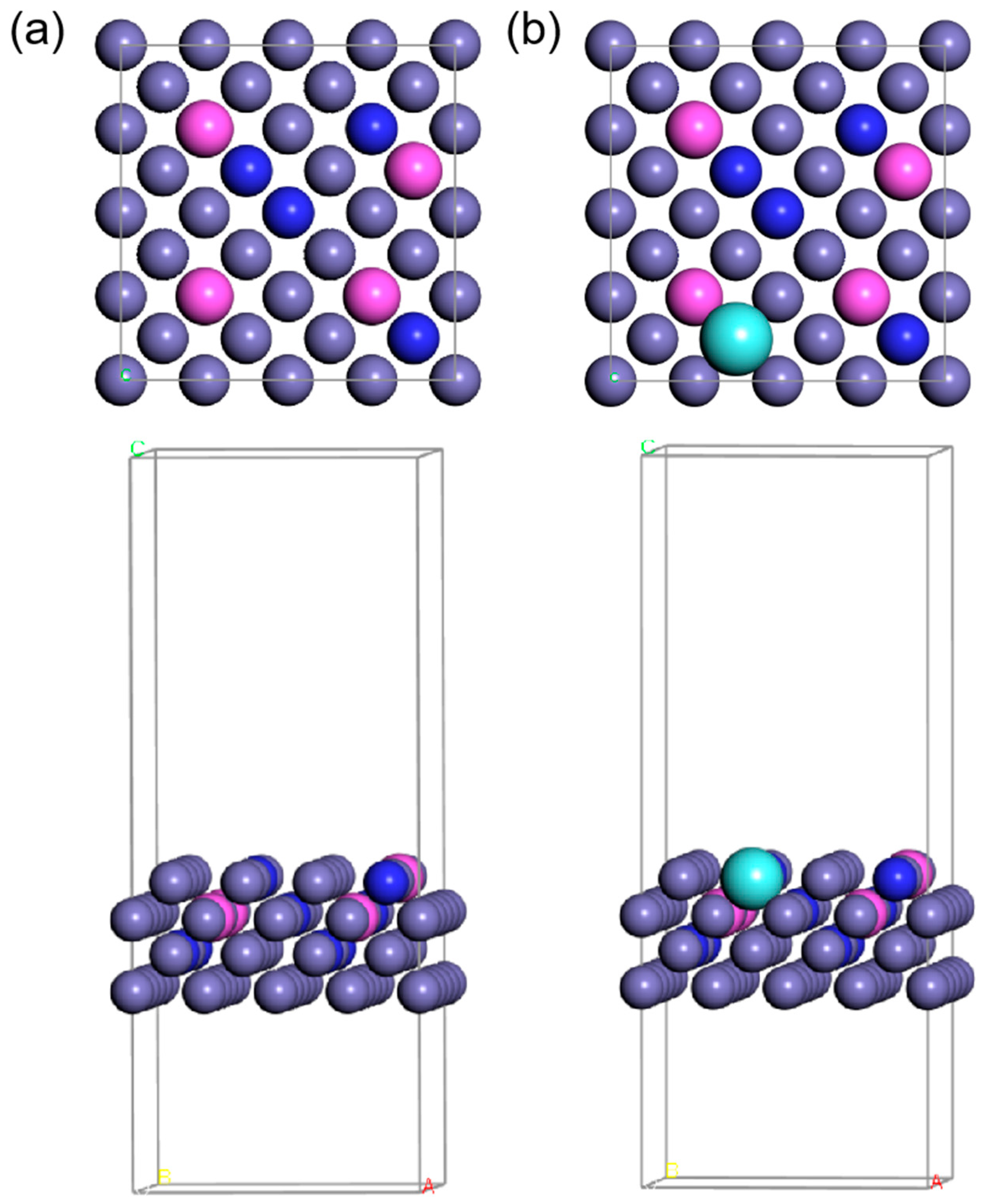
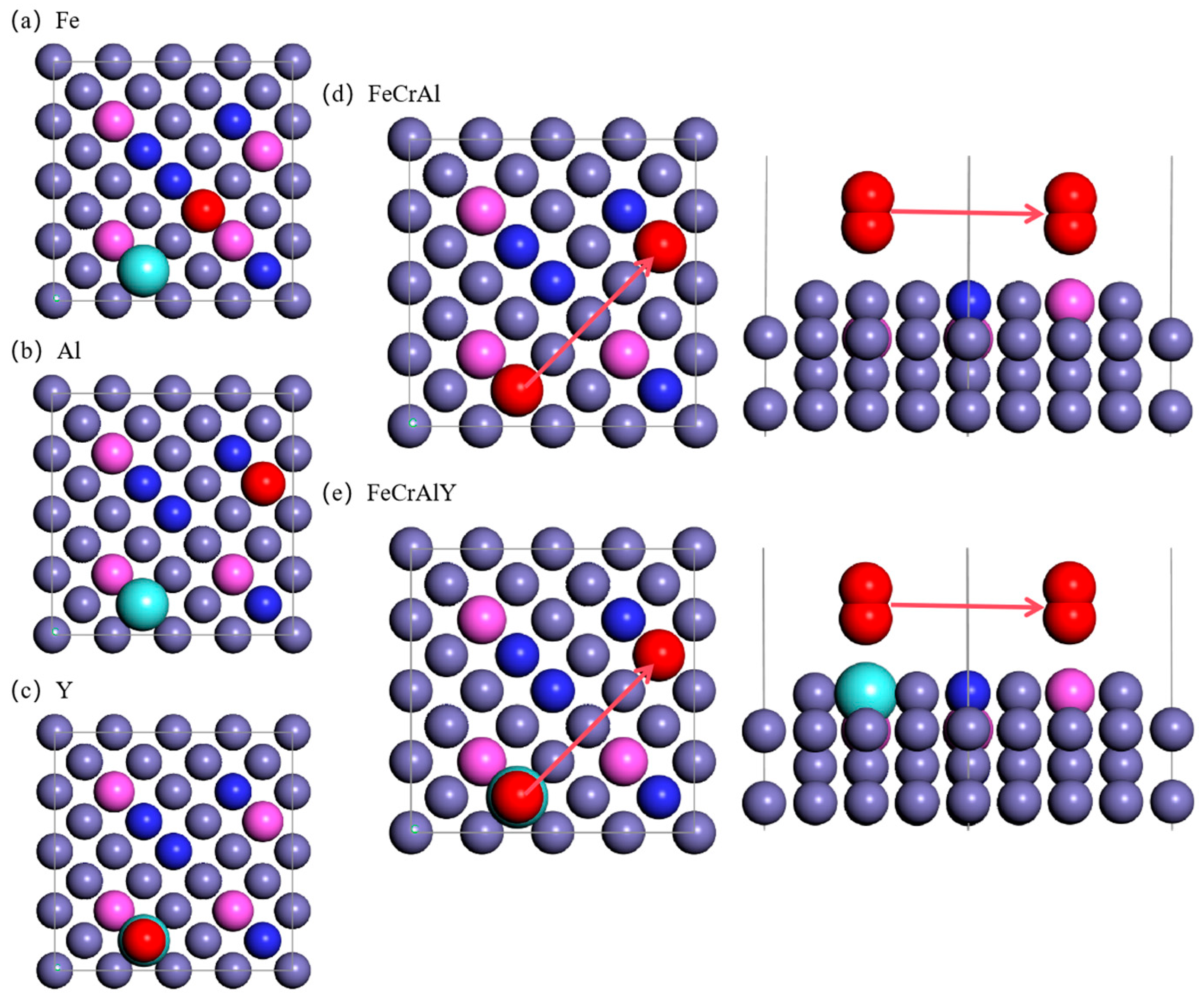


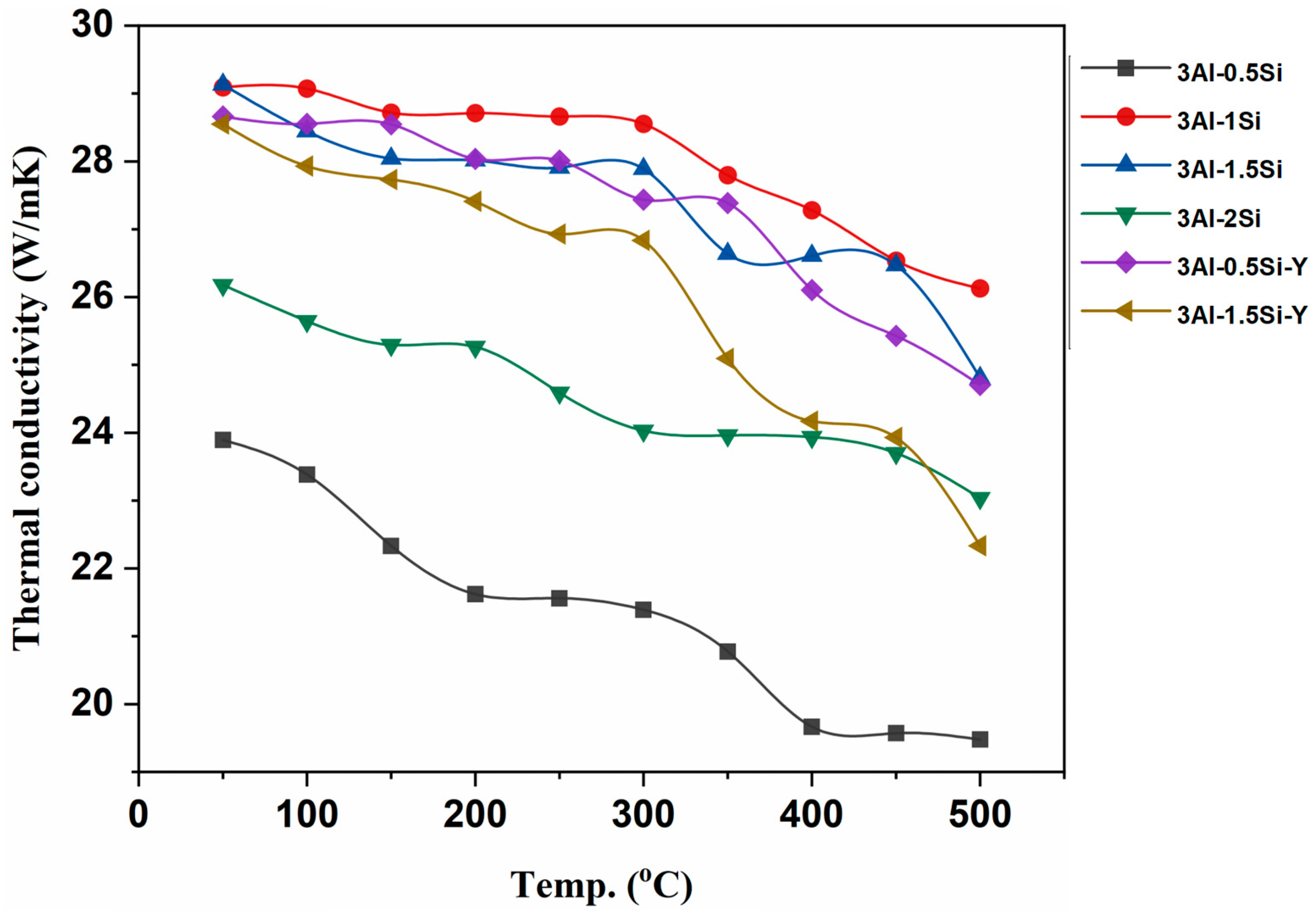


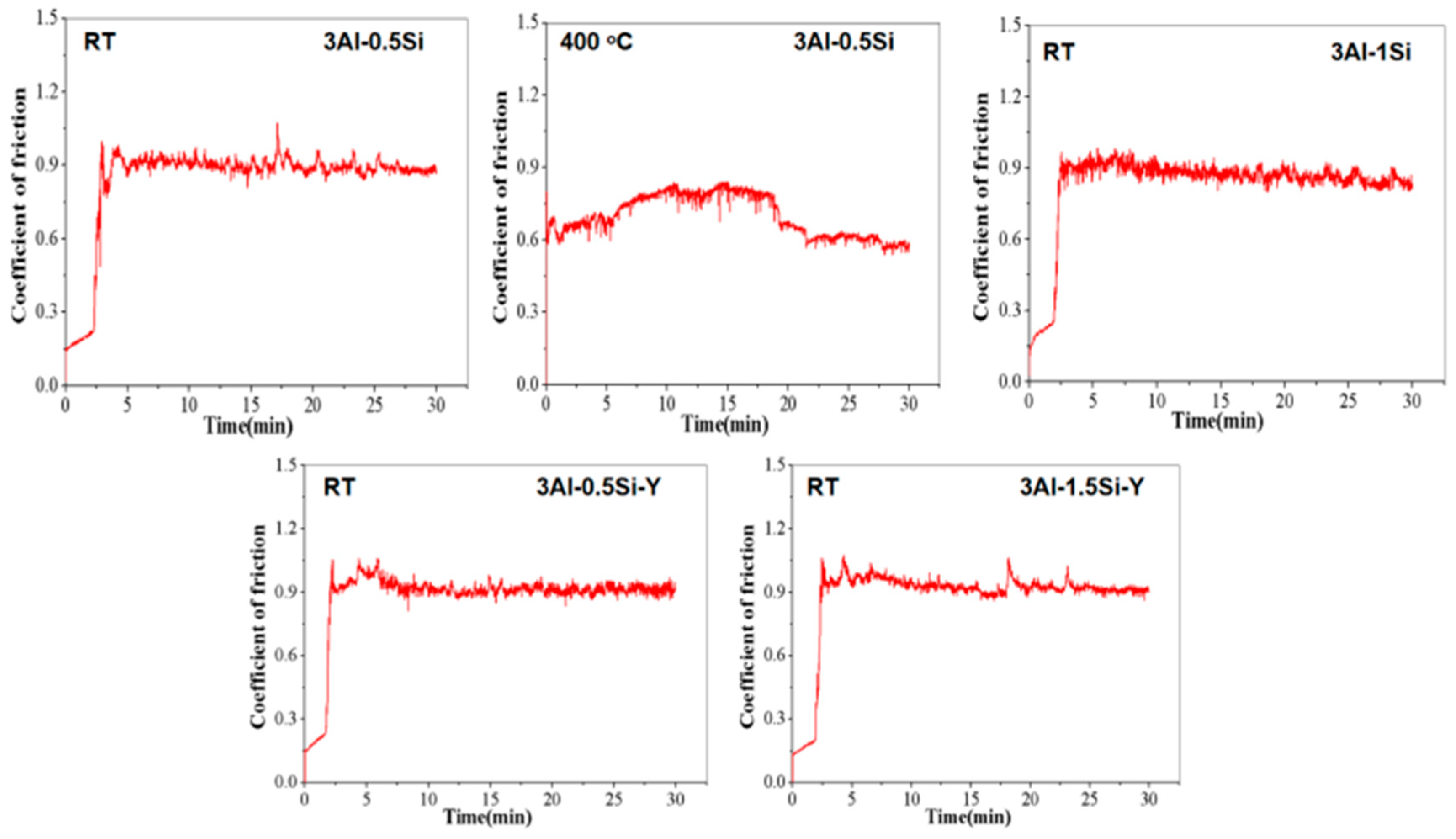


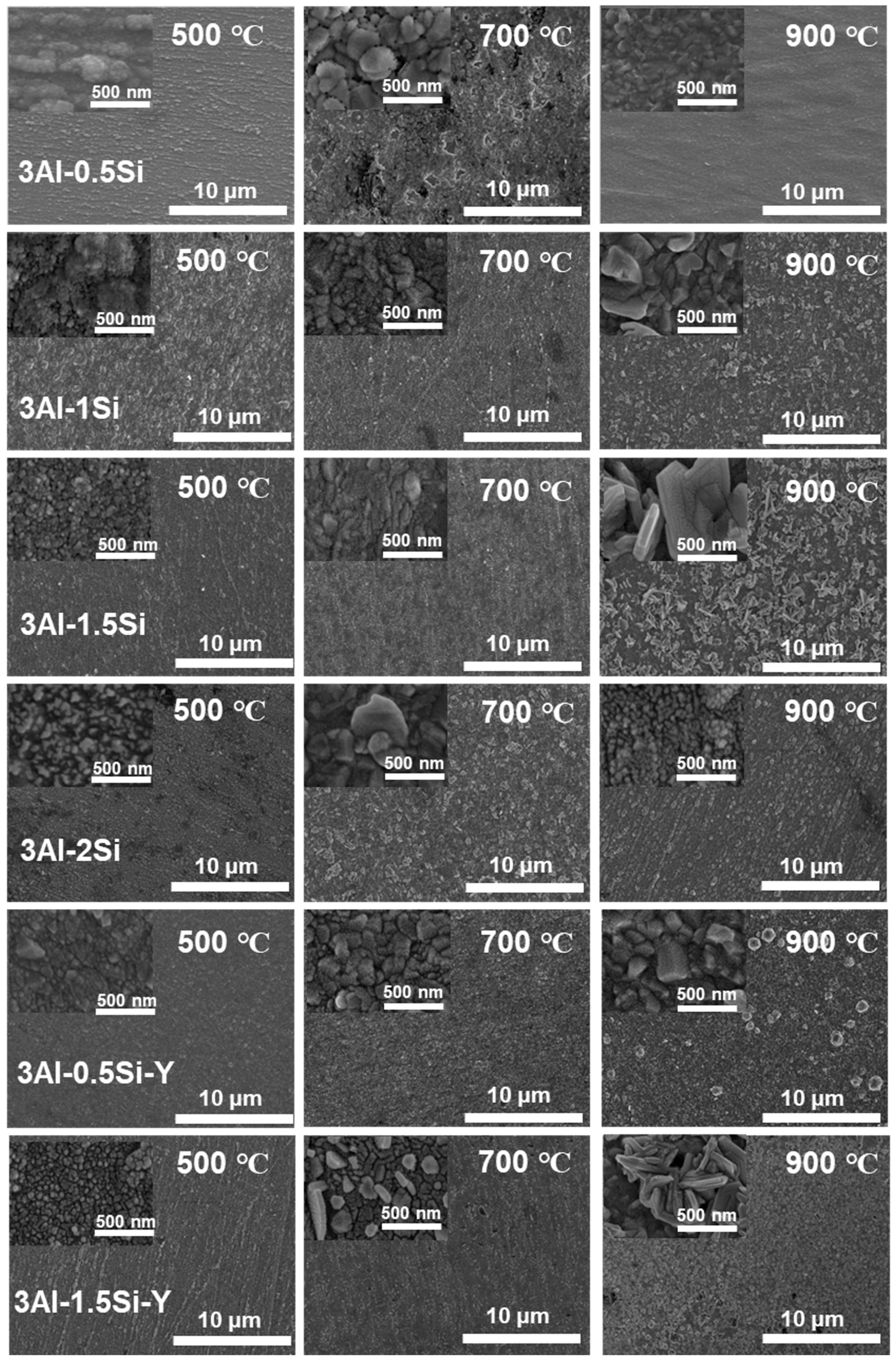
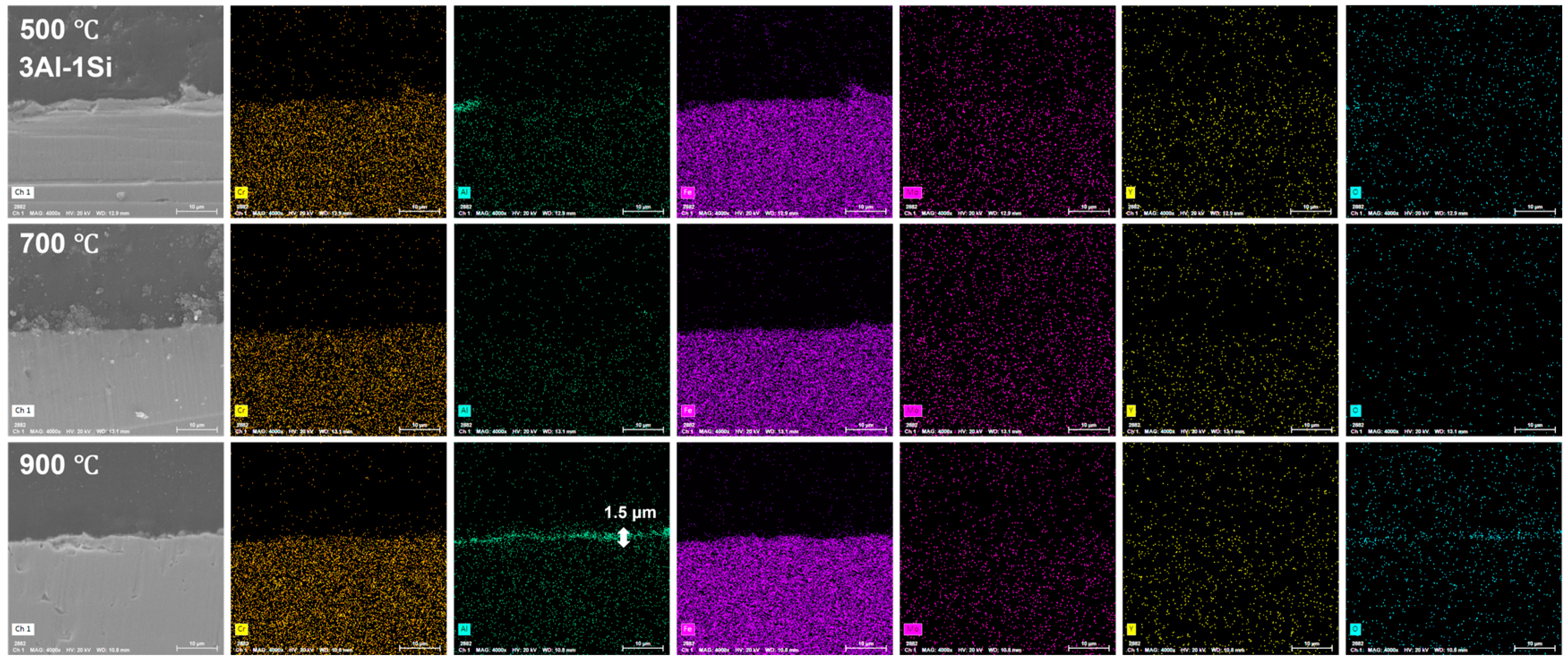
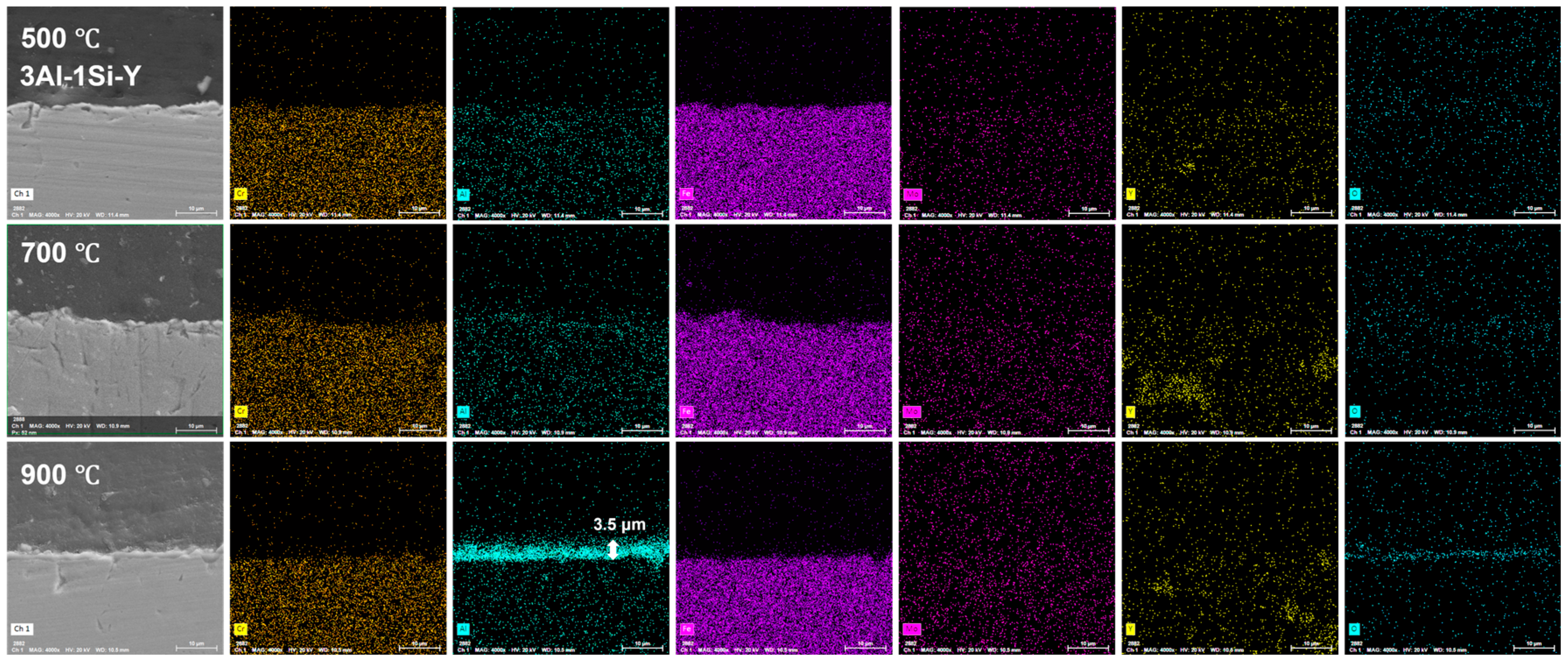

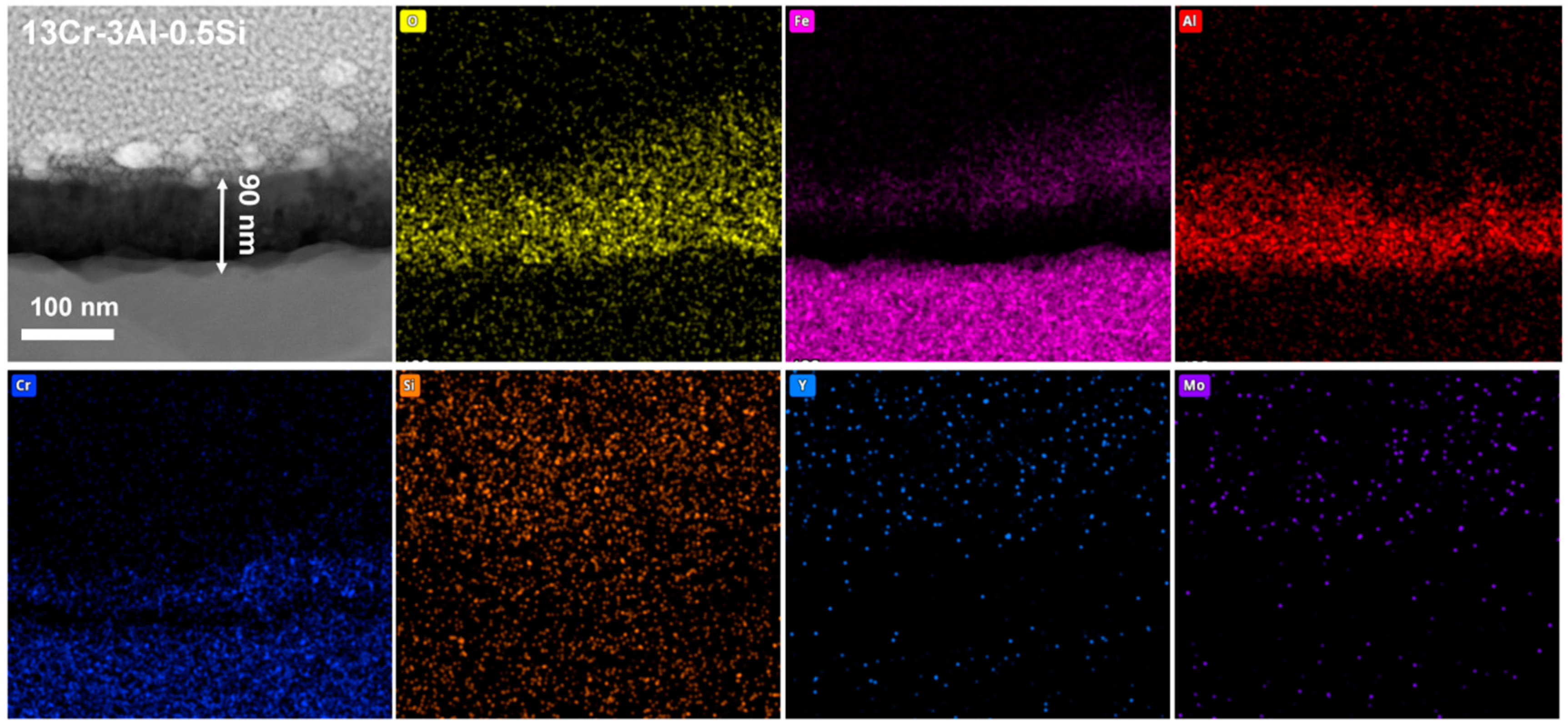
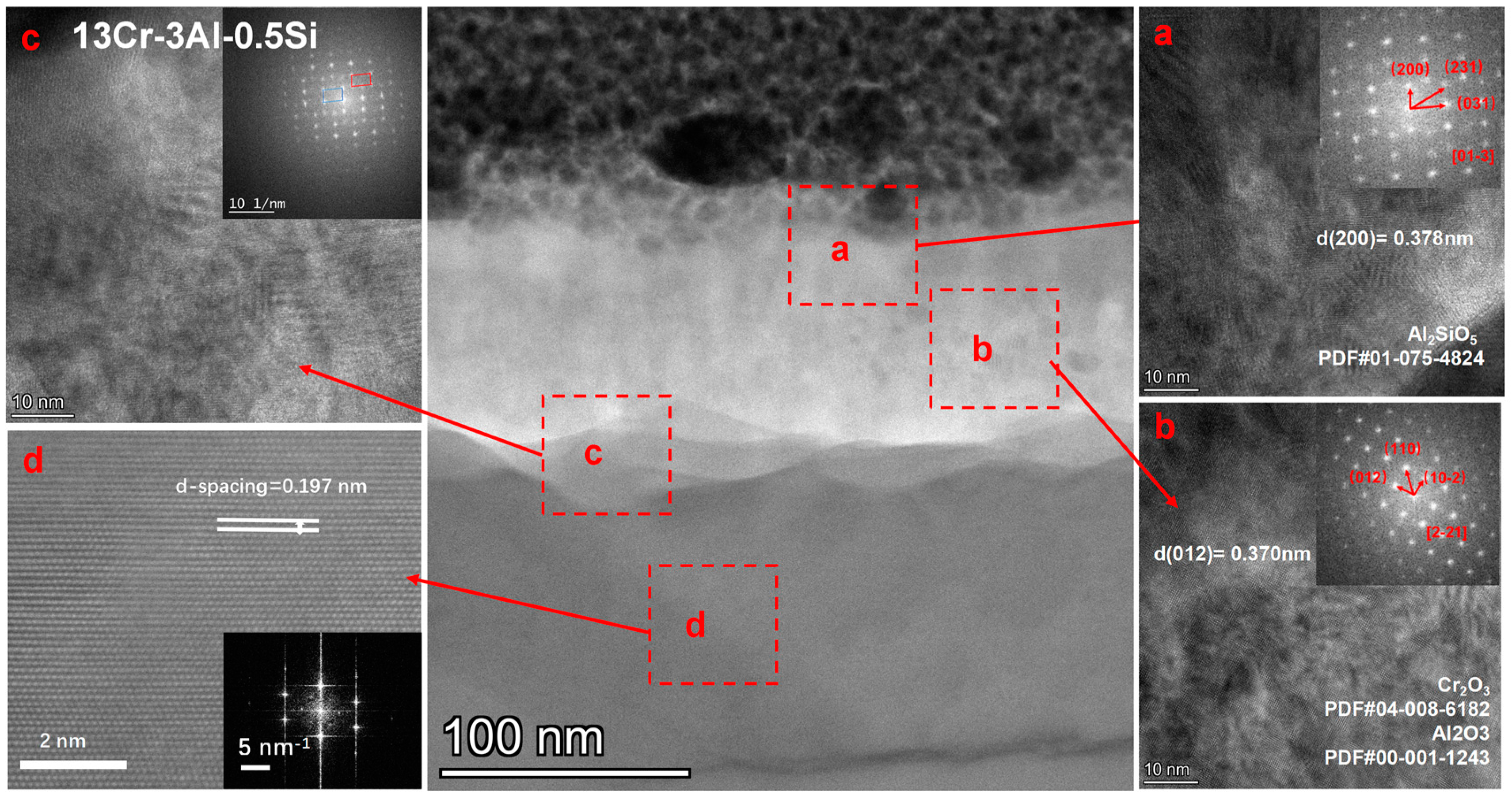

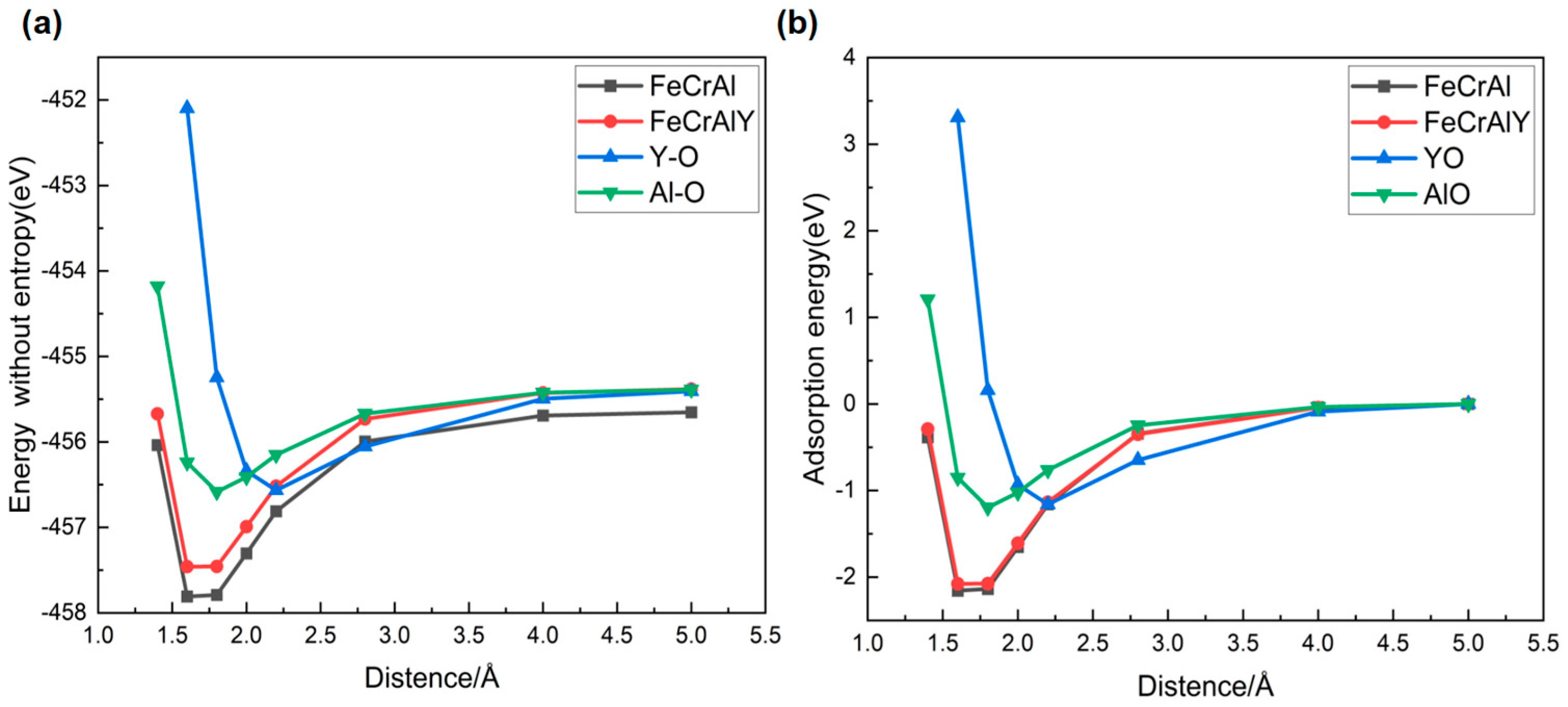
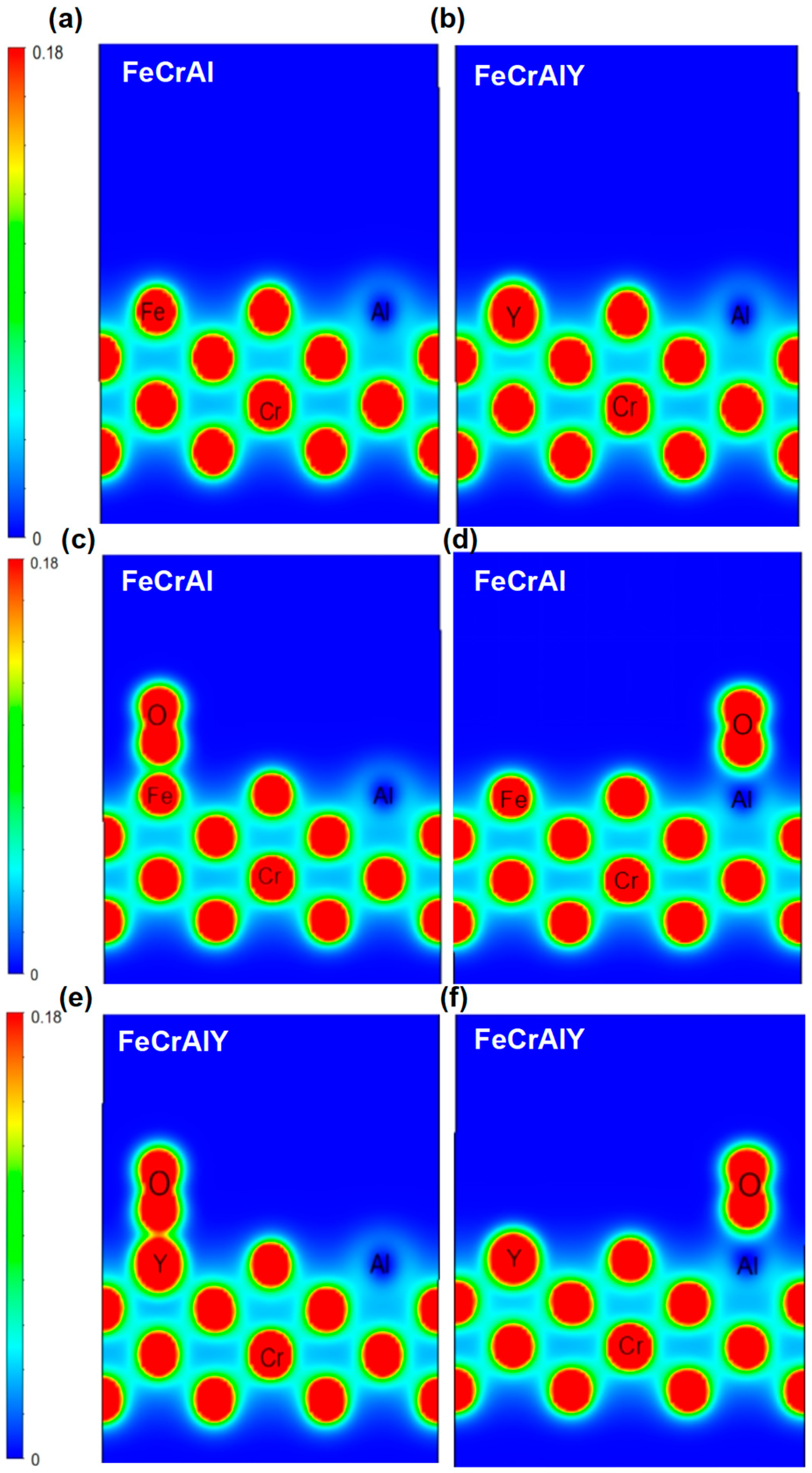
| No. | Chemical Composition | Cr (wt.%) | Al (wt.%) | Si (wt.%) | Y (wt.%) | Fe (wt.%) |
|---|---|---|---|---|---|---|
| 1 | 13Cr-3Al-0.5Si | 12.84 | 3.12 | 0.51 | 0 | balance |
| 2 | 13Cr-3Al-1.0Si | 13.13 | 3.18 | 1.06 | 0 | balance |
| 3 | 13Cr-3Al-1.5Si | 13.07 | 3.13 | 1.64 | 0 | balance |
| 4 | 13Cr-3Al-2.0Si | 12.90 | 3.09 | 2.15 | 0 | balance |
| 5 | 13Cr-3Al-0.5Si-Y | 13.20 | 3.20 | 0.48 | 0.56 | balance |
| 6 | 13Cr-3Al-1.5Si-Y | 13.03 | 3.11 | 1.60 | 0.48 | balance |
Disclaimer/Publisher’s Note: The statements, opinions and data contained in all publications are solely those of the individual author(s) and contributor(s) and not of MDPI and/or the editor(s). MDPI and/or the editor(s) disclaim responsibility for any injury to people or property resulting from any ideas, methods, instructions or products referred to in the content. |
© 2025 by the authors. Licensee MDPI, Basel, Switzerland. This article is an open access article distributed under the terms and conditions of the Creative Commons Attribution (CC BY) license (https://creativecommons.org/licenses/by/4.0/).
Share and Cite
Ni, Y.; Qi, W.; Zhao, L.; Li, D.; Qiao, Y.; Zhou, J.; Wang, P.; Yang, K. Thermo-Mechanical Properties and Oxidation Behavior of FeCrAl Alloys with Si and Y Addition. Metals 2025, 15, 433. https://doi.org/10.3390/met15040433
Ni Y, Qi W, Zhao L, Li D, Qiao Y, Zhou J, Wang P, Yang K. Thermo-Mechanical Properties and Oxidation Behavior of FeCrAl Alloys with Si and Y Addition. Metals. 2025; 15(4):433. https://doi.org/10.3390/met15040433
Chicago/Turabian StyleNi, Yanzhao, Wen Qi, Liangshuo Zhao, Dong Li, Yingjie Qiao, Jingxue Zhou, Peng Wang, and Kun Yang. 2025. "Thermo-Mechanical Properties and Oxidation Behavior of FeCrAl Alloys with Si and Y Addition" Metals 15, no. 4: 433. https://doi.org/10.3390/met15040433
APA StyleNi, Y., Qi, W., Zhao, L., Li, D., Qiao, Y., Zhou, J., Wang, P., & Yang, K. (2025). Thermo-Mechanical Properties and Oxidation Behavior of FeCrAl Alloys with Si and Y Addition. Metals, 15(4), 433. https://doi.org/10.3390/met15040433









